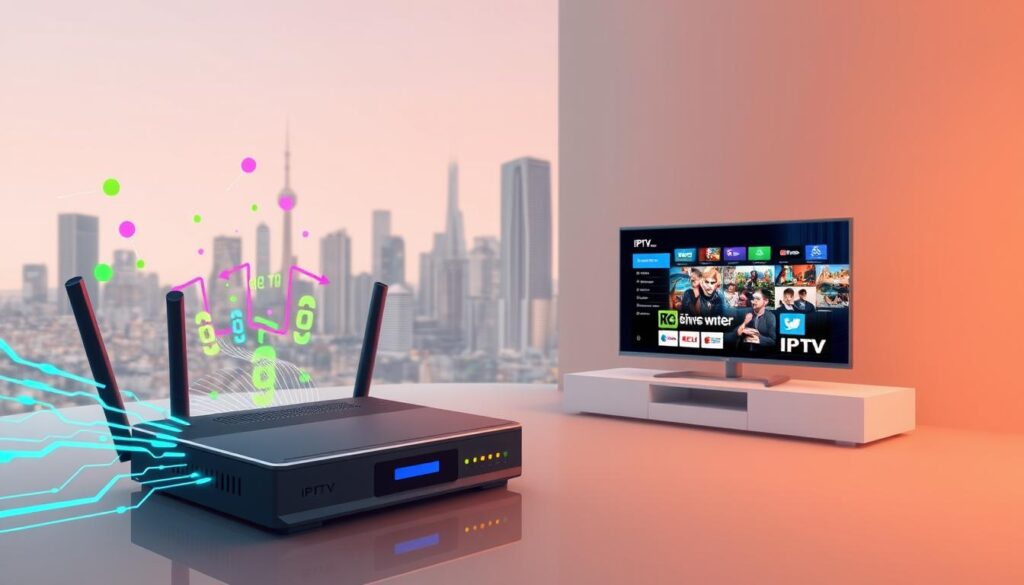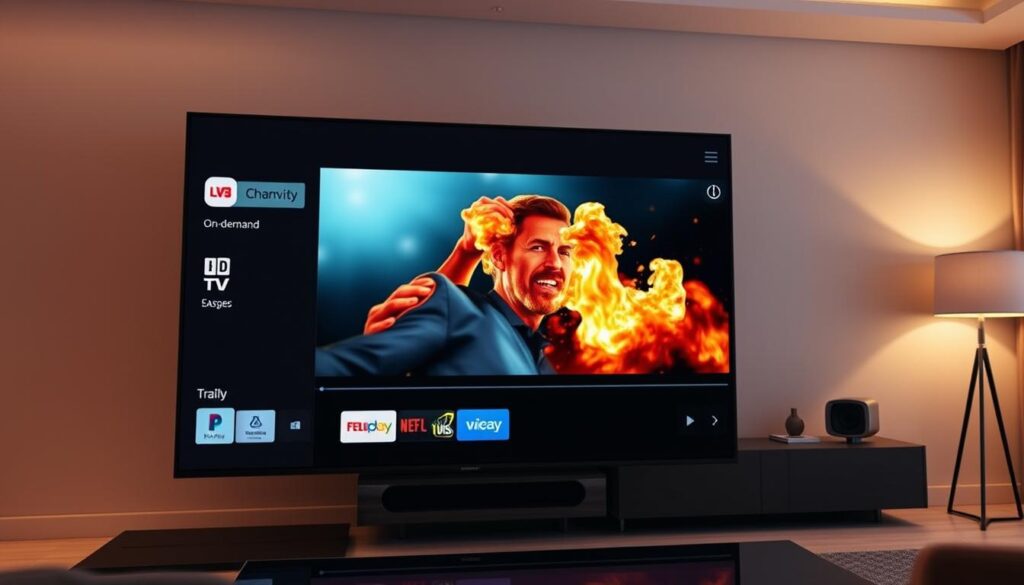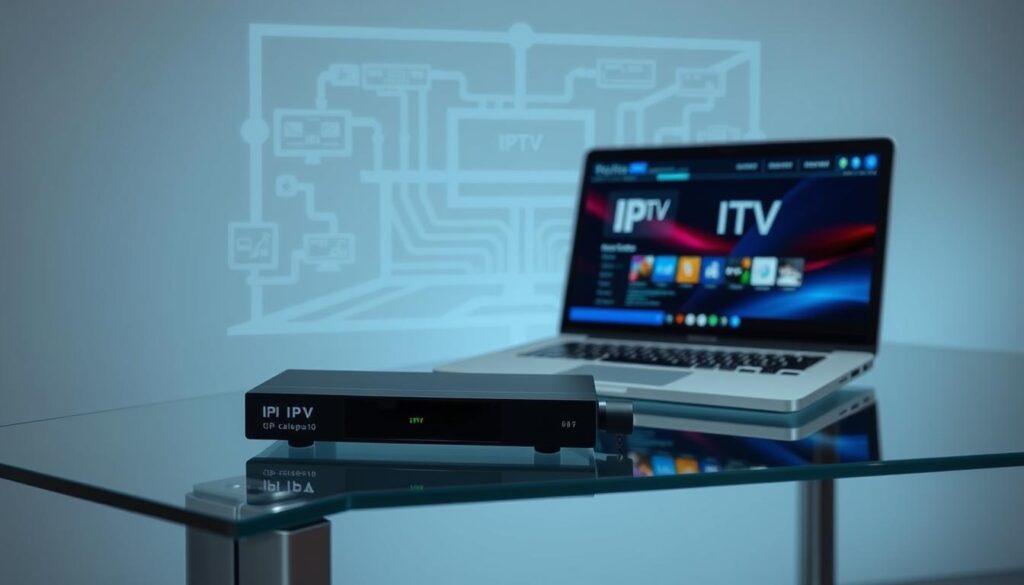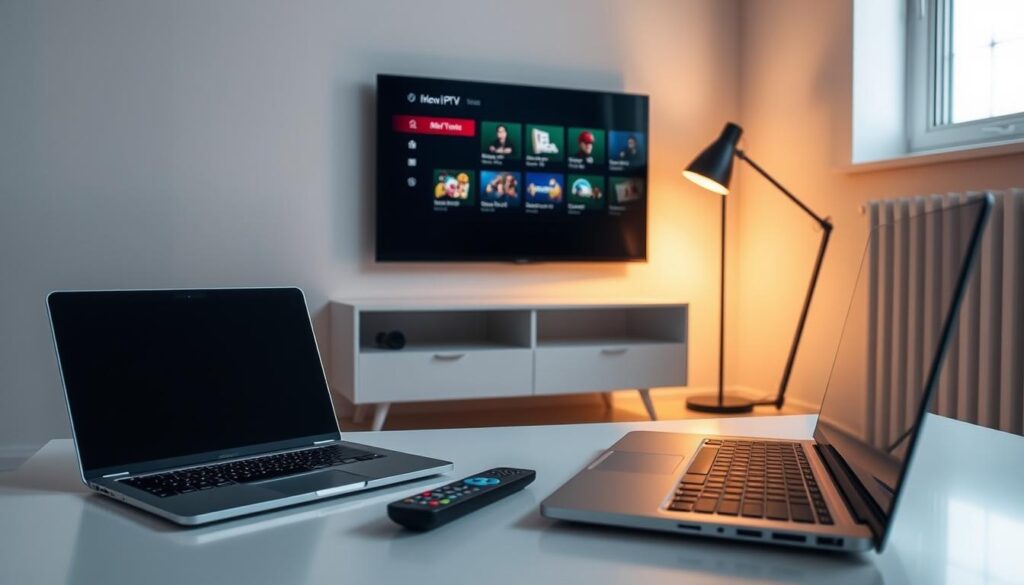As traditional cable services face increased competition, many are turning to IPTV as a modern alternative for streaming content. This article serves as an iptv setup tutorial, guiding you through the process of harnessing the power of IPTV to enjoy endless entertainment. Whether you’re new to IPTV or looking for ways to enhance your streaming experience, we will address common challenges and provide clear, actionable steps to help you navigate this innovative technology.
Key Takeaways
- IPTV presents a flexible option for streaming compared to traditional cable.
- Understanding the technology behind IPTV is crucial for effective usage.
- Setting up IPTV requires essential equipment and a stable internet connection.
- Choosing the right service provider can enhance your IPTV experience.
- Common issues can often be resolved with basic troubleshooting steps.
- Advanced features like Catch-Up TV and VOD can enrich your viewing options.
Introduction to IPTV
IPTV, which stands for Internet Protocol Television, represents a significant advancement in how television content is delivered. Unlike traditional broadcasting methods that rely on satellite or cable systems, IPTV utilizes internet protocols to stream content directly to viewers. This innovative approach allows users to access their favorite shows, movies, and live events seamlessly over the internet.
What is IPTV?
The IPTV definition encompasses a range of services that offer digital television content delivered through internet connections. With its reliance on broadband connectivity, IPTV can provide viewers with high-definition content, interactive features, and a personalized viewing experience. This technology shifts away from conventional broadcast and cable systems, positioning itself as a modern alternative in the media landscape.
Benefits of Using IPTV
The benefits of IPTV are numerous, appealing to a broad audience. Below are some key advantages:
- Flexibility: Users can watch content on various devices, including smart TVs, tablets, and smartphones, making it convenient for on-the-go viewing.
- Vast Content Library: IPTV often offers an extensive selection of channels and on-demand content, providing options beyond traditional cable packages.
- Cost Savings: Many IPTV services tend to be more affordable than traditional cable subscriptions, resulting in potential savings for consumers.
- Enhanced Viewing Experience: Interactive features like pause, rewind, and catch-up TV empower users to have greater control over their viewing habits.
Understanding IPTV Technology
IPTV, or Internet Protocol Television, utilizes advanced technology to stream television content over internet connections, offering a modern alternative to traditional broadcast methods. Unlike conventional cable, IPTV delivers video through IP-based networks, ensuring greater flexibility and efficiency. How to effortlessly use IPTV for the ultimate viewing experience? This section explores how IPTV functions and compares it to traditional cable services, highlighting key differences in performance and user satisfaction.
How IPTV Works
IPTV functions by delivering television programming through broadband internet connections. Instead of relying on conventional satellite or cable infrastructure, IPTV streams content directly to a user’s device. Key components of this system include:
- Content Delivery Networks (CDNs): These networks help distribute video content efficiently across various servers, ensuring quick access and minimal buffering.
- Video on Demand (VOD): Users can select and watch programs at their convenience, rather than relying on predetermined broadcast schedules.
- Interactive Features: IPTV supports features such as pause, rewind, and catch-up TV, offering a more flexible viewing experience than traditional options.
Difference Between IPTV and Traditional Cable
The shift from traditional cable to IPTV introduces a range of distinctions worth noting. Here’s a comparative look:
| Aspect | IPTV | Traditional Cable |
|---|---|---|
| Content Delivery | IP-based streaming via broadband | Coaxial or fiber optic cables |
| Bandwidth Usage | Variable, dependent on user demand | Fixed allocation for channels |
| User Interactivity | High level of interactivity; pause, replay, etc. | Limited interactivity; scheduled viewing only |
| Content Options | Extensive; includes films, live events, and archives | Primarily live programming and on-demand services |

IPTV Setup Guide
Getting started with IPTV involves a few essential tools and straightforward setup steps. How to effortlessly use IPTV for the ultimate viewing experience? This guide walks you through the necessary equipment and provides clear, easy-to-follow instructions to help you set up your IPTV service smoothly across different devices.
Essential Equipment for IPTV
To enjoy IPTV, you need to ensure you have the following items:
- Smart TV or compatible streaming device (Roku, Amazon Fire Stick, Apple TV)
- High-speed internet connection (minimum 10 Mbps recommended)
- IPTV subscription from a reputable service provider
- HDMI cable (if using an external streaming device)
- Wi-Fi router for wireless connections
Steps to Set Up IPTV on Your Device
Follow these steps to set up IPTV effectively:
- Connect your streaming device or smart TV to your television using an HDMI cable.
- Ensure your internet connection is stable.
- Install the IPTV application on your device. Popular options include “Kodi,” “Tivimate,” or the official app from your IPTV provider.
- Launch the app and enter the required details, including your IPTV subscription URL or EPG (Electronic Program Guide).
- Configure settings according to your preferences and save them.
- Restart the app to begin watching your favorite content.
How to Use IPTV: A Step-by-Step Guide
Setting up and using an IPTV service can seem daunting at first. Knowing how to create an IPTV account is essential for accessing various content, including live channels and on-demand movies. This guide will walk you through the process of creating an account and provide tips for efficient IPTV interface navigation.
Creating an IPTV Account
To access your favorite channels and shows, the first step is to create an IPTV account. Follow these general steps, which can often vary slightly depending on the service provider:
- Choose a reputable IPTV service provider and navigate to their official website.
- Locate the “Sign Up” or “Create Account” option on the homepage.
- Fill out the registration form with your personal information, including email address and payment details.
- Verify your email address if required by clicking on the confirmation link sent to your inbox.
- Log in to your account to finalize the setup and configure your preferences.
Navigating Your IPTV Interface
Once your account is established, diving into the IPTV interface can be exciting yet overwhelming. Here’s a straightforward way to enhance your IPTV interface navigation:
- Start by familiarizing yourself with the main menu layout; it usually includes categories like “Live TV,” “Movies,” “Series,” and “Settings.”
- Use the search function to quickly access specific titles or channels.
- Browse through channels and categories for a more exploratory viewing experience. Many interfaces allow filtering by genre or popularity.
- Bookmark favorite channels or shows for easier access in the future.

Best IPTV Practices
When it comes to maximizing your IPTV experience, implementing the best IPTV practices is essential. Key elements include selecting the right IPTV service provider and ensuring a stable internet connection to enjoy uninterrupted streaming. Understanding these factors can enhance viewing satisfaction and overall performance.
Choosing the Right IPTV Service Provider
Selecting an appropriate IPTV service provider is a critical step. Consider important aspects such as:
- Content Variety: A diverse range of channels and on-demand content can significantly improve your experience.
- Pricing: Compare subscription fees and special deals to find a plan that suits your budget.
- Customer Support: Reliable customer service will assist in resolving any technical issues quickly.
- Reliability: Research user reviews to gauge the provider’s track record for consistent performance.
Ensuring a Stable Internet Connection
A strong and stable internet for IPTV is crucial for seamless viewing. Here are several recommendations to guarantee optimal connectivity:
- Check Bandwidth: Ensure your internet plan offers enough bandwidth to support streaming.
- Use a Wired Connection: Whenever possible, connect your device directly to the router via Ethernet for a more stable signal.
- Optimize Wi-Fi Signal: Position your router in a central location to minimize interference and maximize coverage.
- Limit Other Usage: Avoid heavy internet usage by other devices while streaming to maintain quality and speed.
IPTV Streaming Tips
Enhancing your IPTV streaming experience involves various strategies aimed at optimizing performance and broadening content accessibility. Following these iptv streaming tips can significantly improve your enjoyment and satisfaction while using IPTV services.
Optimizing Your Streaming Experience
To achieve the best possible viewing quality, consider the following factors:
- Bandwidth Management: Ensure you have sufficient bandwidth for seamless streaming. Aim for at least 25 Mbps for HD content.
- Device Settings: Adjust resolution and buffering settings on your device to match your internet speed.
- Network Configuration: Use a wired connection when possible to reduce latency and improve stability.
- Router Placement: Place your router in a central location to maximize Wi-Fi coverage and minimize interference.
- Regular Updates: Keep your device and IPTV application updated for optimal performance and access to the latest features.
Exploring Content Options on IPTV
IPTV platforms offer a diverse range of content that caters to various tastes and preferences. You can enjoy:
- Live TV: Access to real-time broadcasts of your favorite shows and events.
- Movies: A vast library of films, from classics to the latest releases.
- On-Demand Shows: Catch up on series and episodes at your own pace.
- Specialized Channels: Discover niche content like international programming, sports, and documentaries.

IPTV User Manual
When it comes to using IPTV devices, having the right user manual is crucial for both beginners and experienced users. How to effortlessly use IPTV for the ultimate viewing experience? It starts with understanding your device. This section focuses on how to access the user manual for your specific IPTV device and explores the common features outlined in these guides. Mastering these features can greatly enhance your overall IPTV experience.
Accessing the User Manual for Your IPTV Device
Finding the right iptv user manual typically involves visiting the manufacturer’s website or checking the documentation that came with your device. Users can often download a PDF version directly online for convenience. Navigating through the manual allows you to understand the functionalities and capabilities of the IPTV service. Familiarizing yourself with these guidelines can simplify the initial setup and usage of your device.
Common Features in IPTV User Manuals
Most iptv user manuals contain information that can improve your overall experience. Common sections include:
- Troubleshooting Guides: Step-by-step instructions for resolving common issues.
- Remote Control Functionalities: Detailed explanations on how to utilize remote features effectively.
- Maintenance Tips: Suggestions for keeping your device in optimal working condition.
By consulting the accessing user manual, you can gain insights into these features and more, ensuring you make the most of your IPTV setup.
IPTV Troubleshooting Steps
Using IPTV can sometimes lead to frustrating experiences due to various playback issues. Identifying the cause of these issues is essential for a seamless viewing experience. This section outlines common problems and valuable tips for troubleshooting and resolving playback issues effectively.
Identifying Common Playback Issues
Playback issues can arise from multiple sources, including network instability and device compatibility problems. Common symptoms include buffering, freezing, or failure to connect. To address these, it’s important to examine the following:
- Internet connection quality and speed.
- Device compatibility with the IPTV service.
- Server issues from the IPTV provider.
- Network congestion during peak usage times.
Steps to Resolve Network Problems
Taking systematic iptv troubleshooting steps can help ensure that your streaming experience remains uninterrupted. Consider the following actions to resolve potential network-related issues:
- Restart your modem and router.
- Check for internet outages with your service provider.
- Connect devices via Ethernet for a more stable connection.
- Adjust your router settings to optimize bandwidth usage.
- Limit the number of devices connected to the network while streaming.
By following these practical tips, users can effectively navigate the complexities of resolving playback issues, enhancing the overall IPTV experience. Keeping your system and network in optimal condition is crucial for the best possible viewing outcomes.
Advanced IPTV Features
The evolution of IPTV technology has introduced a variety of advanced IPTV features that enhance user experience. Key offerings like Catch-Up TV and Video on Demand allow subscribers to engage with content in innovative ways. Understanding these features can transform how viewers consume television and on-demand video.
Using Catch-Up TV and DVR Options
Catch-Up TV offers an essential feature for viewers who may miss live broadcasts. This service enables users to watch previously aired shows and events at their convenience. With advanced DVR options, individuals can record live television for later viewing, ensuring they never miss critical moments. These options cater to busy lifestyles and provide significant flexibility for catching up with TV.
Exploring Video on Demand (VOD) Services
Video on demand (VOD) services elevate IPTV offerings, allowing users to access a vast library of films and series whenever they choose. Subscribers can browse through an extensive catalog and select content based on their preferences. This feature not only diversifies viewing options but also ensures that every viewer can find something to enjoy, thus enriching the overall television experience.
Security and Privacy when Using IPTV
As the popularity of IPTV continues to rise, concerns about security and privacy have become increasingly important for users. Engaging with IPTV services without understanding potential risks can leave personal data vulnerable to breaches. Taking proactive steps to enhance security while enjoying streaming content is crucial for a safe viewing experience.
Protecting Your Data and Privacy
IPTV users often unknowingly expose their sensitive information to cyber threats. Risks can range from having personal data stolen to facing unauthorized access to accounts. Familiarizing oneself with these risks can help mitigate potential issues. Key strategies for protecting data include:
- Using strong, unique passwords for IPTV accounts to prevent unauthorized access.
- Regularly updating device software to include the latest security patches.
- Avoiding public Wi-Fi networks when streaming, as they can be insecure.
Using VPNs with IPTV Services
Integrating a VPN enhances security with IPTV by encrypting internet traffic and masking the user’s IP address. This makes it challenging for third parties to monitor online activities. Benefits of using VPN for IPTV include:
- Improved privacy by hiding user information and location.
- Access to geo-restricted content by connecting to servers in different countries.
- Better protection against potential cyber threats, enhancing overall security with IPTV.
Given the streaming landscape’s growing complexity, employing a VPN stands out as an effective method. Users can enjoy a more secure viewing experience while reducing risks associated with data exposure.
Future of IPTV Technology
The future of IPTV technology is set for major transformation, fueled by innovations in content delivery and connectivity. How to effortlessly use IPTV for the ultimate viewing experience? It lies in the emerging trends that focus on personalization—where smart algorithms analyze viewing habits to recommend tailored content. With the growing integration of artificial intelligence, IPTV platforms are becoming more intuitive, offering users increasingly engaging and relevant entertainment options.
Trends Shaping IPTV Development
Emerging technologies are shaping how IPTV is consumed. Notable trends include:
- Personalized Content Delivery: Services will curate content based on user preferences.
- AI Integration: Intelligent systems will optimize streaming quality and user interactions.
- Multi-Device Compatibility: Seamless viewing across various devices will become standard.
- Enhanced User Interfaces: Improved navigation will facilitate easier content discovery.
How 5G Will Enhance IPTV Services
The roll-out of 5G technology offers significant potential for revolutionizing IPTV services. With faster data speeds and lower latency, viewers can expect:
- High-Quality Streaming: Users will enjoy uninterrupted and crystal-clear viewing experiences.
- Increased Connectivity: More devices can connect simultaneously without service degradation.
- Lower Delays: Real-time interaction with live streams will be enhanced.
- Expanded Content Libraries: Faster networks will enable broadcasters to offer a broader range of content.
Conclusion
In summary of IPTV, this technology has transformed the way we consume media, offering a plethora of benefits that enhance the viewing experience. From the ability to stream live channels to access on-demand content, IPTV provides flexibility and customization that traditional cable services often lack. As we explored throughout this article, knowing how to use IPTV effectively allows users not only to enjoy an extensive range of programming but also to tailor their entertainment choices to fit their lifestyles.
Adopting IPTV means embracing a modern approach to entertainment. With a basic understanding of its technology and setup processes, users can easily navigate various platforms and services, ensuring a seamless viewing experience. As highlighted, featuring additional elements like catch-up TV and Video on Demand enriches the overall offering, making IPTV an attractive alternative for anyone looking to enhance their entertainment options.
By keeping in mind the critical aspects discussed, such as selecting the right service provider and maintaining a stable internet connection, viewers can truly empower themselves in the IPTV landscape. As the industry continues to evolve, staying informed will only add to the benefits of this dynamic and adaptable entertainment solution.

